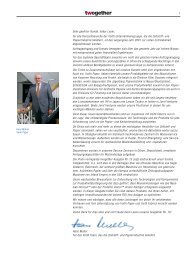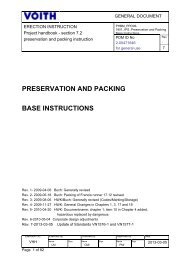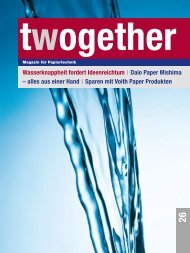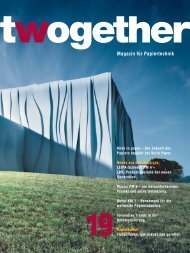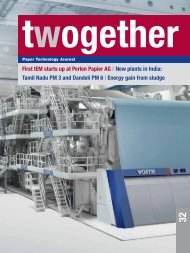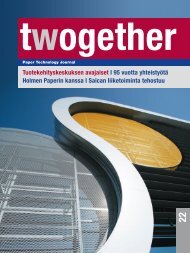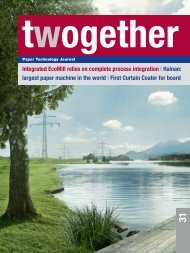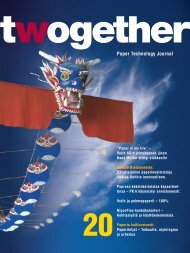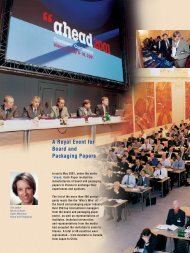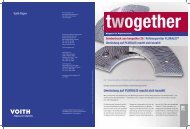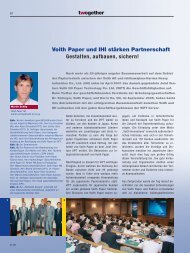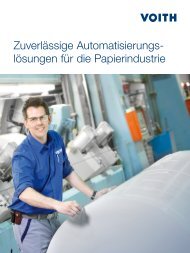Paper Technology Journal 19 - Voith
Paper Technology Journal 19 - Voith
Paper Technology Journal 19 - Voith
Create successful ePaper yourself
Turn your PDF publications into a flip-book with our unique Google optimized e-Paper software.
42<br />
Dr. Harald<br />
Graf-Müller<br />
Silent Technologies<br />
harald.graf-mueller@voith.com<br />
Harald Freytag<br />
Silent Technologies<br />
harald.freytag@voith.com<br />
The starting position<br />
The sound pressure level usual in the<br />
vicinity of paper machines confronts the<br />
design engineers with the task of taking<br />
noise abatement measures. In particular,<br />
the legal provisions for employee protection<br />
and neighborhood protection require<br />
noise reduction measures. The targets<br />
set by <strong>Voith</strong> Silent Technologies are to<br />
pave the way for systematic noise reduction<br />
in paper machines: By the end of<br />
2005, the suction roll noise is to be reduced<br />
by 5 dB, A-weighted, which corresponds<br />
to a sound energy reduction of<br />
68%. The noise level reduction to less<br />
<strong>19</strong>/05<br />
<strong>Voith</strong> Silent Technologies – SeaLencer<br />
The increasing industrialization makes noise a key issue.<br />
The industry, in particular the paper industry, often faces the<br />
problem that the operation of technical equipment is not, or only to<br />
a limited extent, possible if the legal limit values are exceeded.<br />
The pioneering solution of the SeaLencer sealing strip system<br />
developed by <strong>Voith</strong> for suction rolls fully satisfies today’s demands<br />
on noise abatement.<br />
than 90 dB, A-weighted, to be achieved at<br />
operator level on a long-term basis is to<br />
significantly improve the workplace quality<br />
in the vicinity of paper machines. The<br />
suction rolls in the wire and press sections<br />
are the crucial noise sources of a<br />
paper machine. Due to their “noise dominance”,<br />
the acoustic design process<br />
presently focuses on suction rolls.<br />
<strong>Voith</strong>’s acoustic test stand<br />
An acoustic test stand is used to systematically<br />
analyze and optimize the acoustic<br />
characteristics of suction rolls under<br />
standardized conditions. It allows to alter<br />
various physical parameters (such as felt<br />
speed, vacuum, amount of water, etc.)<br />
within wide limits.<br />
In addition to acoustic analyses, innovative<br />
technologies are developed in the research<br />
fields of “wear-optimized design<br />
of seals”, “reduced energy consumption”<br />
and “reduced vacuum losses”. Extensive<br />
studies and tests result in innovative<br />
sealing materials and new seal geometries.<br />
The <strong>Voith</strong> SeaLencer described below<br />
is the result of systematic research<br />
and development for low-noise design on<br />
the acoustic test stand.<br />
<strong>Voith</strong> SeaLencer –<br />
Seals of Silence<br />
A suction roll comprises, among other<br />
things, a perforated roll shell and an<br />
evacuated suction box. Sealing strips are<br />
used to seal the vacuum against the air in<br />
the rotating suction roll and are pressed<br />
against the inside of the suction roll<br />
shell. When conventional sealing strips<br />
are used, the vacuum suddenly collapses<br />
after the sealing strip is passed. Impulses<br />
of high-frequency sound are emitted due<br />
to the abrupt flow of air back into the<br />
holes of the suction roll after leaving the<br />
suction area and produce the annoying<br />
effect of suction roll whistling.<br />
The function of the SeaLencer – patent<br />
applied for – (Fig. 1) is determined by its<br />
special geometry for optimizing the pressure<br />
gradient in the gap above the sealing<br />
strip. The gradual, non-abrupt flow of air<br />
into the suction holes at the bevelled<br />
surfaces results in controlled and uniform<br />
pressure reduction in the holes<br />
(Fig. 2), which is clearly audible: A “softer"<br />
sound with a lower sound pressure<br />
level is created.<br />
A run-up test from 1,000 m/min to 2,200<br />
m/min on the acoustic test stand demon-



